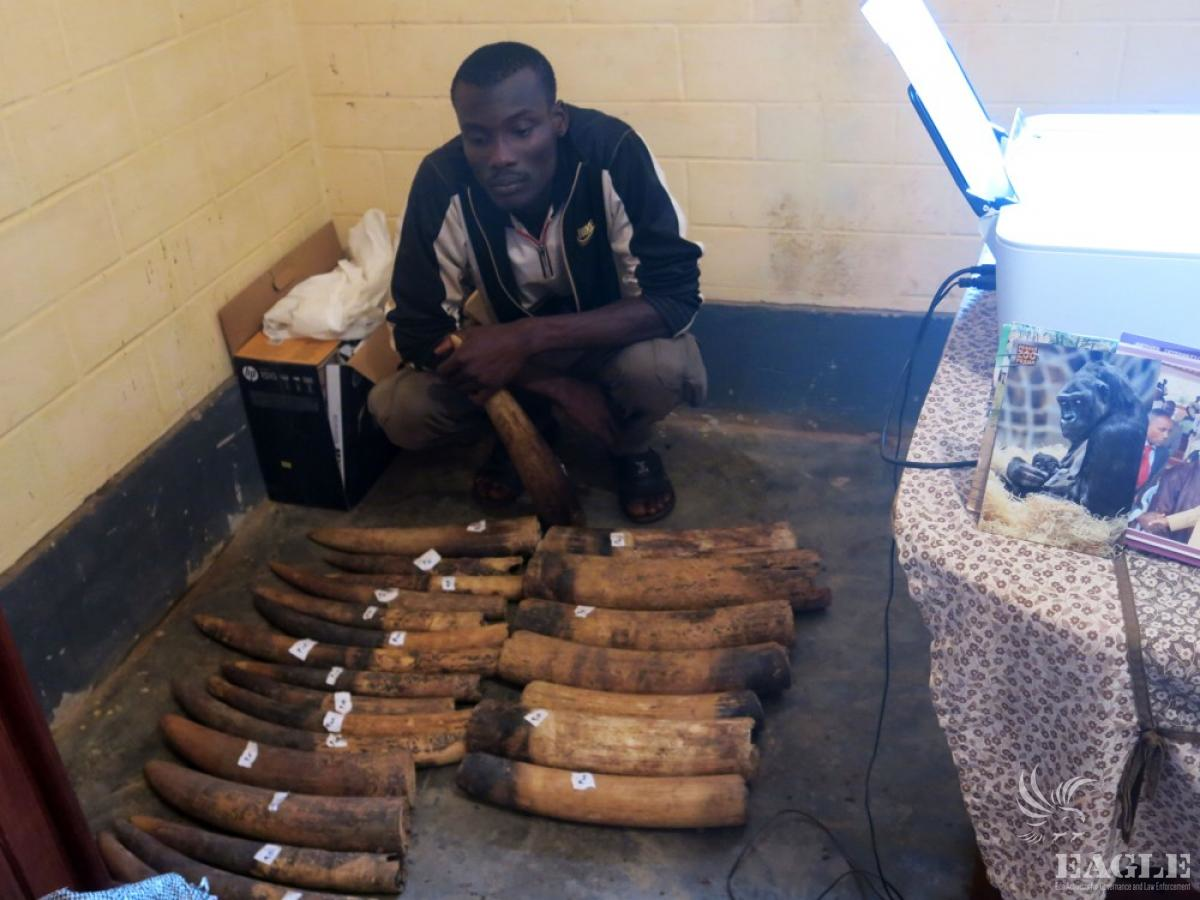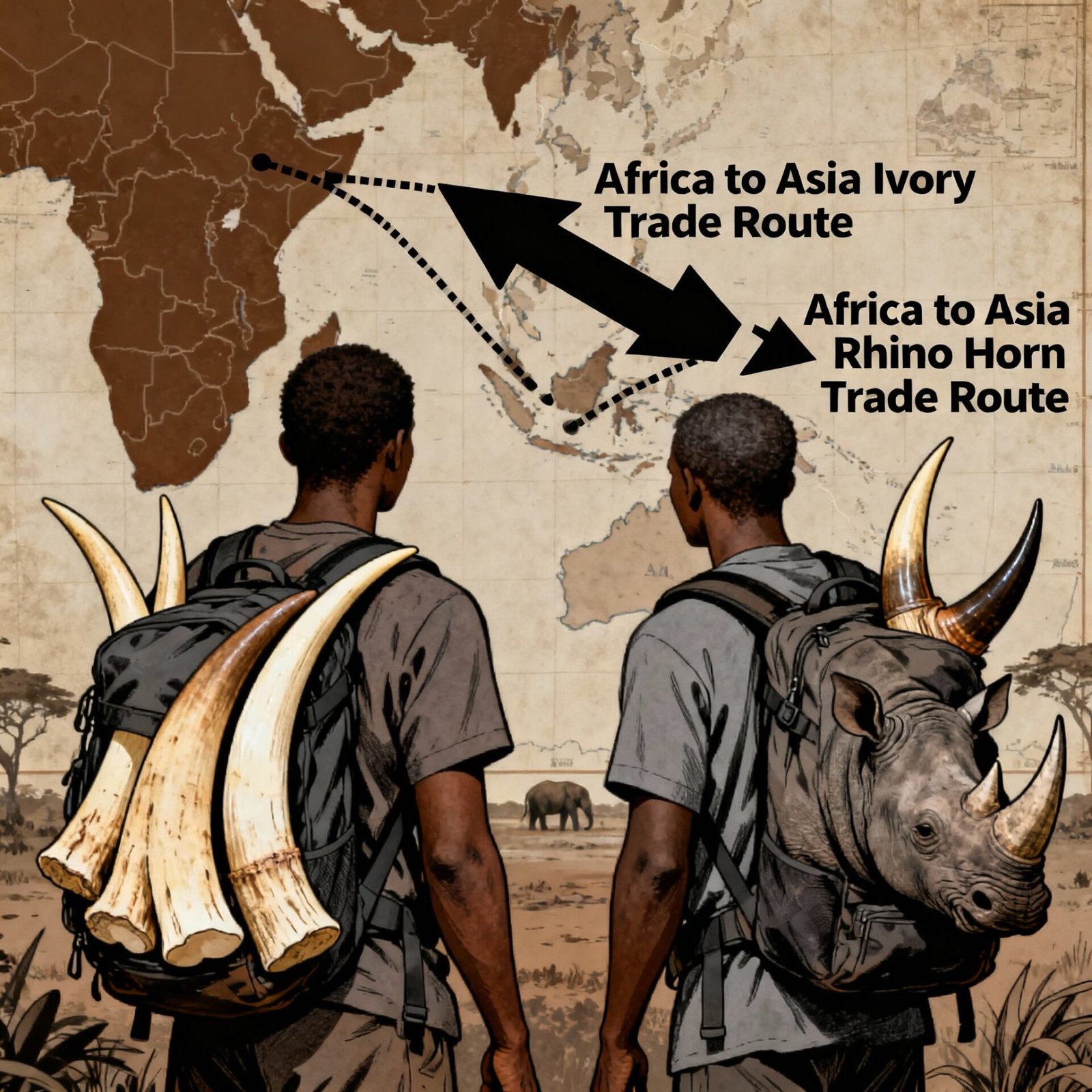The numbers are staggering and the methods barbaric. Every year, criminal syndicates operating across Africa slaughter more than 30,000 elephants, 400 rhinos, and millions of pangolins to feed an insatiable Asian appetite for ivory, horn, and scales. Behind this carnage lies a sophisticated criminal empire worth $20 billion annually that has infiltrated governments, corrupted officials, and turned Africa’s most magnificent creatures into commodities. In this investigation also titled, “The Blood Trade, We reveal and expose How Criminal Syndicates Are Hollowing Out Wilderness through wildlife trafficking networks in Africa”
This investigation, based on months of research into seizures, court documents, and intelligence reports, exposes the hidden networks that have transformed wildlife trafficking from opportunistic poaching into one of the world’s most lucrative transnational crimes. The evidence reveals a web of corruption stretching from village officials to cabinet ministers, from Chinese crime bosses to Vietnamese syndicates, all united in their exploitation of Africa’s natural heritage.

The Architecture of Annihilation
Nigeria: The Continental Hub of Death
Nigeria has emerged as the epicenter of Africa’s wildlife trafficking crisis, handling an estimated 70% of all significant pangolin scale and ivory shipments leaving the continent. The country’s strategic position, weak enforcement, and endemic corruption have made it the preferred launching pad for criminal syndicates moving contraband to Asian markets.
“Nigeria has recognized the issue and is taking steps to nab traffickers,” admits Folashade Morenikeji, a wildlife official, acknowledging what investigators have long known – that her country has become Africa’s primary wildlife trafficking hub.

The scale of the trade is breathtaking. Since 2021, joint operations between Nigerian Customs and the Wildlife Justice Commission have seized 21,582 tonnes of pangolin scales – representing the slaughter of nearly 39 million pangolins. Yet these seizures represent merely 10% of the actual trade, according to trafficking experts.
In December 2024 alone, Nigerian authorities intercepted 2.179 tonnes of pangolin scales, equivalent to approximately 1,100 pangolins, in a single operation targeting a suspected broker believed to be part of a network supplying vast quantities to Lagos-based trafficking organizations.
The Mozambique Gateway
Mozambique serves as both a source and transit hub, particularly for rhino horn trafficking. The country’s 500-kilometer border with South Africa’s Kruger National Park has become a highway for poachers and their contraband. Criminal networks exploit porous borders, corrupt officials, and inadequate law enforcement to move rhino horn, ivory, and other wildlife products through Maputo port to Asian destinations.
The arrest and conviction of Simon Valoi, known as “Navara,” represents a rare victory against these networks. This notorious rhino poaching kingpin, who targeted Kruger National Park for years, was sentenced to 27 years in prison in August 2024. His conviction, along with that of his associate Paulo Zucula, who received 24 years, marked a significant blow to wildlife trafficking networks across southern Africa.
“Valoi is one of the most prolific rhino horn poaching bosses known for primarily targeting Kruger National Park,” stated the Wildlife Justice Commission. At the time of his arrest in July 2022, authorities seized four rhino horns weighing 2.9 kilograms, evidence of his continued criminal activities.
Tanzania: Where Corruption Flows Like the Nile
Tanzania’s elephant population has suffered one of the most dramatic collapses in Africa, plummeting from over 100,000 to fewer than 40,000 between 2009 and recent counts. This catastrophe has been facilitated by systematic corruption involving politicians, military officers, and Chinese criminal syndicates.
Environmental Investigation Agency reports reveal how Chinese-led criminal gangs conspired with corrupt Tanzanian officials to traffic massive quantities of ivory. The corruption reaches the highest levels of government, with former Natural Resources Minister Khamis Kagasheki naming four ruling party MPs as being involved in elephant poaching.
“This business involves rich people and politicians who have formed a very sophisticated network,” Kagasheki stated before being removed from office – a move he attributed to his anti-corruption efforts.
The corruption is so pervasive that even official Chinese government delegations have been implicated. In December 2013, an official visit by a Chinese naval task force to Dar es Salaam created a surge in ivory sales, with one dealer boasting of making $50,000 from sales to naval personnel. A Chinese national was caught attempting to enter the port with 81 illegal tusks intended for two mid-ranking Chinese naval officers.
The Asian Connection: Where Greed Meets Tradition
China’s Ivory Empire
At the heart of the global ivory trade sits the Chinese town of Shuidong in Guangdong Province, described by investigators as “the world’s largest hub for ivory trafficking”. This unremarkable coastal town has become the epicenter of a criminal empire that processes an estimated 80% of all poached ivory smuggled out of Africa.
The Shuidong syndicates demonstrate sophisticated criminal characteristics: significant financial investment, advanced smuggling techniques, facilitation of multiple shipments, reliance on corruption, money laundering capabilities, and trade in multiple species including ivory, pangolins, rhino horn, and fish products.
These criminal networks operate with near impunity. “Since supplanting Chinese gangs from Fujian as the main raw ivory traffickers more than a decade ago, the Shuidong syndicates have remained untouched by any enforcement action in China or abroad,” notes the Environmental Investigation Agency.
The methods employed are increasingly sophisticated. The syndicates use complicit freight agents to submit fraudulent documents for customs clearance, employing a “switching” technique that involves two bills of lading to conceal the origin and destination of containers. They also rely on Chinese black-market moneychangers in Tanzania and Mozambique to facilitate payments, with money paid in Chinese renminbi into designated accounts in China before being distributed as US dollars in Africa.
Vietnam’s Rhino Horn Obsession
Vietnam has emerged as the primary destination for rhino horn, driven by beliefs in traditional medicine despite scientific evidence showing rhino horn has no medicinal properties. The trade is highly lucrative, with rhino horn prices reaching up to $400,000 per kilogram for Asian rhino horn and $20,000 per kilogram for African horn in black markets.
Research among rhino horn consumers in Vietnam reveals the perverse logic driving demand. The illegal status of the trade actually increases its appeal among wealthy consumers, who view rhino horn as a luxury status symbol precisely because it is forbidden and expensive.
“The trade in rhino horn is highly lucrative. In the black market, rhino horn prices can fetch up to $400,000 per kg for Asian rhino horns and $20,000 per kg for African rhino horns,” confirms research into consumer behavior.
The Corruption Highway: How Officials Enable Genocide
Kenya: The Insider Threat
Kenya’s position as a major transit hub for ivory heading to Asia has been compromised by corruption among government officials and private sector operators. A 2016 Wildlife Protection and Trafficking Assessment conducted by TRAFFIC identified corruption among government officials and the transportation industry as key drivers of rhino and elephant poaching.
The corruption often involves officials providing critical intelligence to poachers. “Corrupt action, committed by anyone from low-level field personnel to heads of departments and ministers, facilitates grassroots, opportunistic criminals as well as powerful networks,” reports the United Nations Office on Drugs and Crime.
Cases document the systematic nature of the corruption. In March 2016, four Administration Police officers were charged with illegal possession of 5 kilograms of ivory they may have been attempting to sell. The case exemplifies how those sworn to protect wildlife have become complicit in its destruction.
Elizabeth Gitari, a legal officer at Wildlife Direct in Kenya, suggests that some corruption hides behind apparent incompetence. She points to cases against poachers compromised by defective charge sheets, which she believes may be deliberate efforts by lower-level officials to ensure cases are not heard.
The Transport Sector’s Complicity
The ability to move large quantities of wildlife products across continents requires extensive collusion within the transportation industry. TRAFFIC analyses consistently show increasing numbers of large-scale ivory seizures involving 500 kilograms or more, indicating greater sophistication and higher levels of corruption between private sector operators and public sector regulators.
“Organized crime is often affected through means of collusion, corruption and protection that covertly link private sector operatives with public sector regulators and law enforcers at important trade bottlenecks such as border crossings, airports or seaports,” notes research on corruption in wildlife trafficking.
In the Philippines, some wildlife traders routinely ship contraband through airports without concealing illicit wildlife or providing appropriate permits. In Madagascar, officials at checkpoints do not confiscate banned timber but systematically extort tolls from transporters.
Money Laundering: The Financial Web of Wildlife Crime
The financial infrastructure supporting wildlife trafficking represents one of its most vulnerable yet least investigated aspects. Despite being a $20 billion annual industry, only 1% of wildlife crime cases involve money laundering investigations.
This failure to follow the money allows criminal syndicates to operate with near impunity. “Wildlife crime syndicates move, hide, and launder the profits and proceeds of wildlife crime through various means, undermining the financial integrity of both financial and non-financial systems,” reports research into illicit financial flows.
The methods employed are diverse and sophisticated. Criminals use mobile money transfers, particularly popular in sub-Saharan Africa where formal banking is limited. They also exploit special economic zones, manipulate stockpile management systems, and use established money laundering techniques including the use of front companies and shell corporations.
South Africa’s Pioneering Response
South Africa has emerged as a leader in treating wildlife trafficking as a financial crime. The South African Anti-Money Laundering Integrated Task Force (SAMLIT), established in 2019, represents the first public-private partnership specifically targeting wildlife trafficking finances.
“In the last two years, South Africa has seen the emergence of charges relating to money laundering and racketeering being added to wildlife crime possession and trafficking charges,” reports SAMLIT research. This approach has yielded results, with rhino horn trafficker Ping Wu receiving a five-year prison sentence for money laundering related to rhino horn trafficking in January 2024.
International Comparisons: Lessons from Global Failures and Successes
Thailand’s Enforcement Success
Thailand’s approach to wildlife trafficking demonstrates how coordinated international operations can achieve results. In May 2024, Thai authorities intercepted a wildlife trafficking convoy, uncovering hundreds of radiated tortoises, lemurs, and other endangered species valued at over $2 million. The operation resulted from intelligence-led investigations and international cooperation.
Indonesia’s Ongoing Struggles
Indonesia faces similar challenges to African countries, with organized groups within protected areas like Ujung Kulon National Park killing endangered Javan rhinos. Corruption and insider information from officials facilitate these crimes, demonstrating how institutional weaknesses enable wildlife trafficking regardless of geography.
Brazil’s CITES Exploitation
Brazil’s experience shows how international regulations can be exploited. Unregulated breeders exploit gaps in CITES to smuggle threatened species, primarily to markets in Europe, China, and the United States. This demonstrates how criminal networks adapt to regulatory frameworks designed to protect wildlife.
The Human Cost: Voices from the Frontlines
Rangers Under Fire
The human cost of wildlife trafficking extends far beyond animal casualties. In the Democratic Republic of Congo, wildlife rangers face some of the most dangerous conditions on Earth, battling Mai Mai militias who control poaching operations.
“We fight against truly dangerous groups, they are soldiers. It’s a real war,” says Ghislain Somba, deputy head of Garamba National Park. The park has lost 114 elephants in a single year despite rangers’ efforts, representing nearly 10% of the park’s elephant population.
The Mai Mai Morgan militia, led by elephant poacher Paul Sadala, has committed murder, rape, torture, beheading, and cannibalism in their efforts to control poaching territories. In 2012, Mai Mai Simba rebels killed two wildlife rangers and 13 endangered okapi at the Okapi Wildlife Reserve in retaliation for anti-poaching efforts.
“There are no words to describe the loss of the okapi at the station, some of which have been in residence for over 23 years and all made it through seven years of civil war unscathed,” wrote John Lukas, head of the Okapi Wildlife Reserve.
Community Displacement and Poverty
Wildlife trafficking often exploits poverty and displaces local communities. In Uganda, investigations reveal that park rangers have used violent methods against subsistence poachers, eroding the rule of law. In Kenya, the establishment of protected areas banned native hunting without providing alternatives, pushing communities into poverty and displacing them from ancestral lands.
The Technology Arms Race
High-Tech Countermeasures
Anti-poaching efforts increasingly rely on advanced technology. Reserves use drones, night-vision equipment, radar systems, motion-detection cameras, and artificial intelligence. Rhinos are equipped with tracking devices, and rangers conduct patrols with K-9 units.
Criminal Innovation
Criminal networks continuously adapt their methods. They exploit online platforms for sales, use encrypted communications, and employ increasingly sophisticated concealment techniques. DNA analysis reveals that pangolin scales seized in Asia often come from multiple African countries, indicating continental-scale criminal operations.
Following the Money: Financial Intelligence Failures
The failure to investigate the financial aspects of wildlife trafficking represents a critical weakness in enforcement efforts. A joint UN Office on Drugs and Crime and Asia Pacific Group on Money Laundering survey found that despite 86% of countries reporting wildlife crime impacts, only 11% conducted investigations into wider criminal networks beyond poachers or couriers.
“Money laundering investigations, charges or prosecutions were conducted in just one per cent of wildlife crime cases,” the survey revealed. This failure perpetuates the perception among criminal syndicates that wildlife trafficking is a low-risk, high-profit opportunity.
China’s Policy Reversals: Legitimizing Demand
China’s 2018 decision to legalize “controlled” use of rhino horn and tiger bone for medical use represents a dangerous policy reversal. After maintaining a 25-year ban on rhino horn trade, China’s decision to allow its use from “farmed” animals threatens to legitimize demand and provide cover for illegal trade.
“With wild tiger and rhino populations at such low levels and facing numerous threats, legalized trade in their parts is simply too great a gamble for China to take,” warned the World Wildlife Fund.
The policy allows qualified hospitals and doctors to use rhino horn and tiger bone, while also permitting trade in products qualifying as “cultural relics.” Conservation groups fear this will provide cover for illegal activities and increase demand for wild animal parts.
Investigative Methodology and Data Sources
This investigation draws on multiple sources including:
- UN Office on Drugs and Crime World Wildlife Crime Report 2024
- Wildlife Justice Commission intelligence reports
- Environmental Investigation Agency undercover investigation
- TRAFFIC seizure databases and analysis
- Court documents and conviction records
- Law enforcement intelligence and arrest records
- Academic research on consumer behavior
- Financial intelligence and money laundering reports
The Path Forward: Breaking the Criminal Networks
Strengthening International Cooperation
Recent successes demonstrate the power of international cooperation. The conviction of Simon Valoi in Mozambique resulted from coordination between SERNIC and the Wildlife Justice Commission. Operation SAMA 2024 brought together 35 countries and resulted in 104 confiscations across 19 African countries.
Financial Investigation Imperative
The key to disrupting wildlife trafficking networks lies in following the money. “The only way to destroy these networks is to establish how money from the proceeds of wildlife crime is wired or laundered,” states IFAW investigator Paul Bubi.
Technology and Intelligence Sharing
Platforms like the Eastern Africa Trade in Wildlife Information Exchange (TWIX) facilitate real-time information sharing between law enforcement agencies. These tools enable rapid response to cross-border crimes and help identify trafficking patterns.

The Time for Half-Measures Has Ended
The evidence presented in this investigation demands immediate action. Wildlife trafficking networks have evolved into sophisticated criminal enterprises that threaten not only Africa’s iconic species but also the continent’s security, governance, and economic development.
The solutions require political will, international cooperation, and sustained investment in law enforcement capacity. Most critically, governments must begin treating wildlife trafficking as the serious transnational organized crime it has become, employing the full arsenal of financial investigation tools, asset forfeiture powers, and international judicial cooperation mechanisms.
The choice is stark: act decisively now to dismantle these criminal empires, or watch as Africa’s natural heritage disappears into the insatiable maw of illegal international markets. The evidence is clear, the methods are known, and the time for action is now.
The future of Africa’s wildlife – and the integrity of its institutions – hangs in the balance.
About Our Investigation
This investigation represents months of research into one of the world’s most destructive criminal enterprises. Our team analyzed court documents, seizure records, intelligence reports, and academic studies to expose the networks destroying Africa’s wildlife. We interviewed law enforcement officials, conservationists, and legal experts across multiple countries to document the scale and sophistication of these criminal operations.
Citations and Sources
Helping Rhinos. (2025). Rhino Poaching in 2024.
BBC. (2016). East Asian networks ‘smuggle ivory across Africa’.
Mongabay. (2024). No signs of slowdown in wildlife trafficking in 2024 as demand persists.
Save the Rhino. (2025). 420 Rhinos Poached in South Africa in 2024.
UNODC. (2023). World Wildlife Report.
WCO Magazine. (2019). China Customs disrupts major wildlife trafficking syndicate.
Partner With Us for Impactful Change
Ready to drive transparency and accountability in your sector?
Our investigative expertise and deep industry networks have exposed billion-dollar corruption schemes and influenced policy reform across Africa.
Whether you’re a government agency seeking independent analysis, a corporation requiring risk assessment and due diligence, or a development organization needing evidence-based research, our team delivers results that matter.
Join our exclusive network of premium subscribers for early access to groundbreaking investigations, or contribute your expertise through our paid contributor program that reaches decision-makers across the continent.
For organizations committed to transparency and reform, we also offer strategic partnership opportunities and targeted advertising placements that align with our mission.
Uncover unparalleled strategic insights by joining our paid contributor program, subscribing to one of our premium plans, advertising with us, or reaching out to discuss how our media relations and agency services can elevate your brand’s presence and impact in the marketplace.
Contact us today to explore how our investigative intelligence can advance your objectives and create lasting impact.


